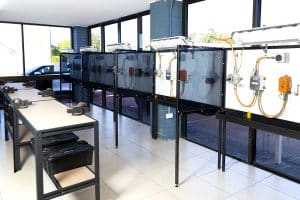Some Known Details About Roar Solutions
Some Known Details About Roar Solutions
Blog Article
9 Simple Techniques For Roar Solutions
Table of ContentsRoar Solutions Things To Know Before You Get ThisThe Greatest Guide To Roar SolutionsOur Roar Solutions Statements
In order to shield installations from a potential explosion an approach of analysing and identifying a possibly dangerous location is required. The purpose of this is to ensure the proper option and installation of equipment to ultimately protect against an explosion and to guarantee safety and security of life.
(https://au.enrollbusiness.com/BusinessProfile/7095102/ROAR%20Solutions)
No equipment must be set up where the surface area temperature level of the devices is greater than the ignition temperature of the given hazard. Below are some common dust hazardous and their minimum ignition temperature. Coal Dirt 380C 225C Polythene 420C (melts) Methyl Cellulose 420C 320C Starch 460C 435C Flour 490C 340C Sugar 490C 460C Grain Dust 510C 300C Phenolic Material 530C > 450C Aluminium 590C > 450C PVC 700C > 450C Residue 810C 570C The chance of the danger being existing in a concentration high adequate to trigger an ignition will vary from area to place.
In order to classify this threat an installation is separated right into locations of threat relying on the amount of time the hazardous exists. These locations are referred to as Areas. For gases and vapours and dusts and fibers there are 3 areas. Zone 0 Area 20 A hazardous environment is extremely most likely to be present and might exist for extended periods of time (> 1000 hours annually) or perhaps continuously Zone 1 Zone 21 A dangerous atmosphere is feasible but unlikely to be existing for long durations of time (> 10 450 C [842 F] A category of T6 means the minimum ignition temperature level is > 85 C [185 F] Unsafe location electrical equipment possibly developed for usage in greater ambient temperatures. This would showed on the ranking plate e.g. EExe II C T3 Ta + 60C( This suggests at 60C ambient T3 will certainly not be surpassed) T1 T1, T2, T3, T4, T5, T6 T2 T2, T3, T4, T5, T6 T3 T3, T4, T5, T6 T4 T4, T5, T6 T5 T5, T6 T6 T6 A T Course rating of T1 means the maximum surface temperature level produced by the tool at 40 C is 450 C. Thinking the associated T Course and Temperature level rating for the devices are ideal for the area, you can always make use of a tool with a more strict Division rating than required for the area. There isn't a clear solution to this inquiry unfortunately. It truly does rely on the kind of equipment and what fixings need to be brought out. Equipment with details test treatments that can not be done in the field in order to achieve/maintain third celebration score. Need to come back to the factory if it is before the tools's service. Area Repair Work By Authorised Personnel: Challenging testing might not be needed however specific treatments may require to be followed in order for the devices to preserve its third party rating. Authorised personnel need to be utilized to execute the job correctly Fixing have to be a like for like replacement. New part should be taken into consideration as a direct substitute calling for no special testing of the equipment after the repair service is full. Each tool with a harmful rating ought to be examined independently. These are outlined at a high level below, but for even more in-depth details, please refer directly to the guidelines.
The Greatest Guide To Roar Solutions
The tools register is a thorough data source of equipment documents that consists of a minimum set of areas to determine each item's area, technological parameters, Ex-spouse classification, age, and environmental information. The ratio of Thorough to Shut assessments will be figured out by the Devices Risk, which is examined based on ignition risk (the chance of a source of ignition versus the probability of a combustible atmosphere )and the unsafe area category
( Zone 0, 1, or 2). Executing a durable Risk-Based Evaluation( RBI )approach is important for ensuring conformity and safety in taking care of Electrical Devices in Hazardous Locations( EEHA).
The Best Strategy To Use For Roar Solutions

In terms of eruptive danger, a dangerous location is a setting in which an explosive ambience exists (or may be anticipated to be present) in amounts that need unique preventative measures for the building, installation and usage of devices. hazardous area course. In this post we explore the difficulties faced in the office, the danger control procedures, and the needed expertises to work securely
It issues of contemporary life that we make, keep or manage a series of gases or liquids that are regarded combustible, and a series of dirts that are regarded combustible. These compounds can, in particular problems, form explosive ambiences and he said these can have significant and tragic repercussions. The majority of us are acquainted with the fire triangle eliminate any type of among the 3 elements and the fire can not happen, however what does this mean in the context of hazardous areas? When breaking this down right into its most basic terms it is essentially: a combination of a specific amount of launch or leakage of a certain substance or material, blending with ambient oxygen, and the existence of a resource of ignition.
In many instances, we can do little concerning the levels of oxygen in the air, however we can have considerable impact on resources of ignition, as an example electrical devices. Dangerous locations are recorded on the unsafe location classification drawing and are identified on-site by the triangular "EX" sign. Here, among various other crucial info, zones are divided right into three types depending on the hazard, the likelihood and period that an eruptive environment will exist; Zone 0 or 20 is regarded one of the most harmful and Zone 2 or 22 is deemed the least.
Report this page